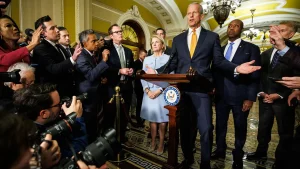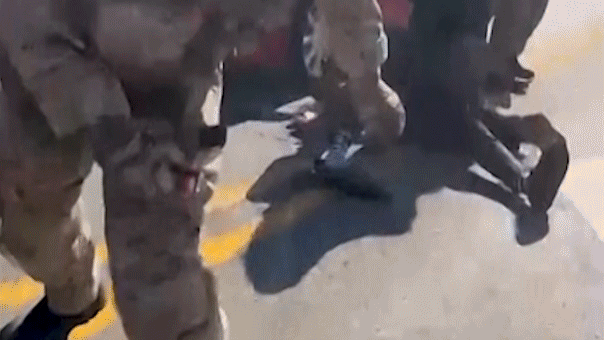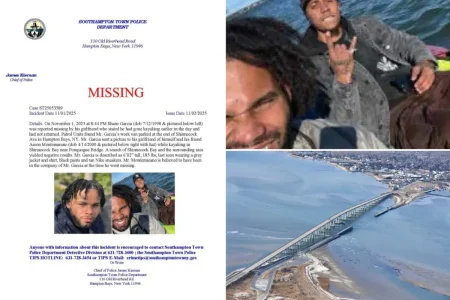Border Patrol Confrontation in Chicago Suburb Escalates into Violent Arrest
A confrontation between U.S. Border Patrol agents and civilians in Evanston, Illinois turned violent last Friday, highlighting the growing tensions between federal immigration authorities and local communities. According to the Department of Homeland Security, the incident began when a red civilian vehicle “aggressively tailgated” a Border Patrol vehicle. When agents attempted to make a U-turn, the two vehicles collided, setting off a chain of events that would escalate dramatically. What followed was captured on video and quickly spread through social media: federal agents wrestling suspects to the ground, physical blows being exchanged, and a hostile crowd gathering to confront the authorities. In the footage, one can hear a suspect claiming he couldn’t breathe during the struggle, while bystanders shouted profanities and attempted to intervene in the arrest.
The Department of Homeland Security provided their account of the incident, stating that one of the suspects physically assaulted a Border Patrol agent through a particularly sensitive attack. Assistant Secretary Tricia McLaughlin explained, “As he was being arrested, he grabbed the agent’s genitals and squeezed them. As you know this is an extremely painful experience for most human beings and justifies certain responses, the agent delivered several defensive strikes to the agitator to free his genitals from the agitator’s vice.” The DHS also reported that a “hostile crowd” surrounded the agents, verbally abusing them and spitting on them as the situation intensified. The confrontation resulted in at least one or two additional arrests beyond the initial driver, according to local reports from FOX 32 Chicago, though the exact number remains unclear from official sources.
The incident didn’t occur in a vacuum but rather amid heightened community vigilance regarding immigration enforcement in Evanston. Local residents have established “rapid response” teams specifically designed to monitor federal agents and alert community members when they are operating in the area. These civilian monitoring groups represent a growing trend in communities with significant immigrant populations, where residents have organized to provide warnings and support when Immigration and Customs Enforcement (ICE) or Border Patrol agents are conducting operations. The existence of these monitoring networks highlights the deep divide between federal immigration enforcement priorities and the values expressed by some local communities, particularly in areas that have declared themselves sanctuaries or safe spaces for immigrants regardless of documentation status.
Evanston’s mayor, Daniel Biss, responded forcefully to the incident, calling for more residents to join the city’s “rapid response” teams and emphasizing that the city has designated certain municipal properties as “No ICE Zones” through local ordinances. At a news conference following the event, Biss’s language became even more pointed: “It is an outrage. Our message for ICE is simple: Get the hell out of Evanston.” The mayor claimed federal agents had “assaulted Evanston residents, beaten people up, grabbed them,” and “abducted them,” using language that reflects the deep mistrust some local officials have toward federal immigration enforcement. Biss also promised to continue tracking the movements of federal agents in and around Evanston and ensure that the Evanston Police Department would respond “in the appropriate fashion,” suggesting a coordinated local government response to federal immigration enforcement activities.
This confrontation in Evanston is not occurring in isolation but reflects similar tensions elsewhere in Illinois. Recent reports indicate that ICE officers in the state have been targeted by individuals who allegedly used “vehicles as weapons” against federal agents. Additionally, there have been situations where local police were reportedly ordered not to respond after attacks on federal agents, creating a complex and potentially dangerous environment for law enforcement operations. These incidents reveal the practical implications of policy differences between federal immigration authorities and local governments, especially in jurisdictions that have adopted sanctuary policies or otherwise limited cooperation with federal immigration enforcement. The tensions expose how immigration enforcement has become not just a policy disagreement but a flash point for physical confrontations between authorities and communities.
The Evanston incident illustrates the deeply polarized nature of immigration enforcement in America today. On one side stand federal authorities tasked with enforcing national immigration laws, operating under directives from Washington. On the other side are local communities and officials who have taken active measures to resist these enforcement efforts, viewing them as harmful to community cohesion and public safety. In between are ordinary people—both immigrants and citizens—caught in a system where even routine encounters can escalate into violent confrontations. As cities like Evanston formalize their opposition to federal immigration operations through ordinances, monitoring networks, and public statements, the fundamental question remains: how can a nation reconcile enforcement of its immigration laws with the autonomy of local communities who reject those enforcement actions? The incident in Evanston provides no easy answers but instead highlights how immigration enforcement has become one of the most visible manifestations of the broader tensions between federal authority and local governance in contemporary America.











